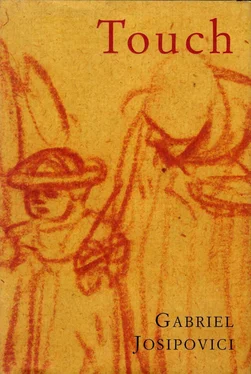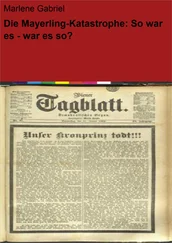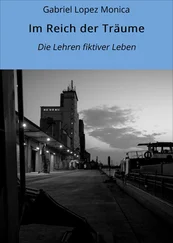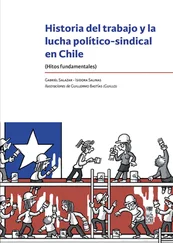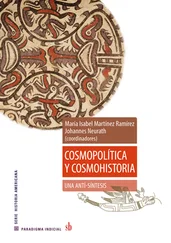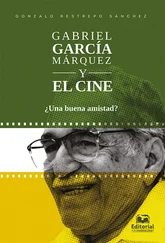Gabriel Josipovici - Touch
Здесь есть возможность читать онлайн «Gabriel Josipovici - Touch» весь текст электронной книги совершенно бесплатно (целиком полную версию без сокращений). В некоторых случаях можно слушать аудио, скачать через торрент в формате fb2 и присутствует краткое содержание. Год выпуска: 1996, ISBN: 1996, Издательство: Yale University Press, Жанр: Современная проза, на английском языке. Описание произведения, (предисловие) а так же отзывы посетителей доступны на портале библиотеки ЛибКат.
- Название:Touch
- Автор:
- Издательство:Yale University Press
- Жанр:
- Год:1996
- ISBN:0300066902
- Рейтинг книги:5 / 5. Голосов: 1
-
Избранное:Добавить в избранное
- Отзывы:
-
Ваша оценка:
- 100
- 1
- 2
- 3
- 4
- 5
Touch: краткое содержание, описание и аннотация
Предлагаем к чтению аннотацию, описание, краткое содержание или предисловие (зависит от того, что написал сам автор книги «Touch»). Если вы не нашли необходимую информацию о книге — напишите в комментариях, мы постараемся отыскать её.
Touch — читать онлайн бесплатно полную книгу (весь текст) целиком
Ниже представлен текст книги, разбитый по страницам. Система сохранения места последней прочитанной страницы, позволяет с удобством читать онлайн бесплатно книгу «Touch», без необходимости каждый раз заново искать на чём Вы остановились. Поставьте закладку, и сможете в любой момент перейти на страницу, на которой закончили чтение.
Интервал:
Закладка:
12. Jean-Baptiste Chardin, Glass of Water and Coffee-pot , 1761. (Carnegie Museum of Art, Pittsburgh; Howard A. Noble Collection, 66.12)
And now we move out into the open. A young man leans over a stone parapet. Leafy branches surround him. A glass, four-fifths full of a milky liquid and with what might be a spoon sticking out of it, stands on the parapet beside him. He leans far over, anchored by his left arm which is bent at the elbow, and resting his right arm on his left wrist. With the tips of the fingers of his right hand he holds a straw, one end of which is in his mouth. He is blowing bubbles, and a huge bubble has in fact just formed at the end of the straw, on a level with the parapet which is visible through the transparent film of the giant bubble.
His coat appears to be torn at the right shoulder, and his long hair, caught up at the back, has escaped at the sides, giving him something of the appearance of an orthodox Jew. To his left, a little surprisingly, a face is visible, topped by a curious twisted hat and cut off at the mouth by the parapet. Though the eyes of this figure appear to be staring straight at us, it is in fact at the bubble, which floats between him and us, that he is gazing. However, he is too much in shadow for us to be able to make this out with certainty. The eyes of the youth are lowered over his straw.
What these young men and boys are doing is in no way significant or important. They are not figures from Greek or Roman mythology, nor are they biblical or historical characters. There is nothing about them we need to know, for there is, in a sense, nothing about them that is worth knowing. The young man with the pen is probably a draughtsman, but what we see him engaged on is merely preparatory to the exercise of his profession. As for the other three, they seem merely to be passing the time.
Passing the time, but not only that, the scholars tell us: they are positively wasting time. These, we are told, are vanitas images, showing the ways in which idle youths waste their time; or rather, the ways in which Idle Youth Wastes Its Time. But the absurdity of this suggestion, which has been current since his day, is so blatant that it merely highlights the fact that there is something peculiarly resistant to interpretation in these paintings of Chardin, so simple and so quiet, so wondrously beautiful. A gap opens up between our immediate, physical response to them and the ability of the intellect to provide explanations for them: Why these boys? Why doing these things? What is Chardin trying to tell us?
Proust, who did not write about these works but did sketch out a little essay on Chardin's still lifes which he never completed, is, as one might expect from someone who knew how to look and could think about what he saw and then express it powerfully and elegantly, closer to the mark. He suggests that the still lifes, those beautifully painted arrays of pots and jugs and simple kitchen shelves, give us the feeling of the quotidian, not in the sense that they are ordinary but in the sense that they are felt to be in daily use. The very way the paint is put on conveys to us not only the constant use to which the depicted objects are put but also the loving care with which they are made. The worn roughness of their surface, so different from the high polish of most contemporary still lifes painted in order to demonstrate the status and wealth of their owners, conveys at once the quality of such craftsmanship and the wear and tear they have endured in years of household use. And this becomes the central feature of the painting itself, as though Chardin's own work on it was akin both to that of the craftsman who made the utensils and of the maidservant who uses them day in day out as she goes about her work.
Proust, who knew all about the iterative mode, all about the skill required of the novelist if he is to convey the sense of the regularity of days which pass by, each essentially the same, rather than the exciting plot development which is the staple of the common novelist, could well appreciate what Chardin was up to. At the same time he could bring out what Chardin's contemporaries and later commentators have found so disturbing about his canvases: the complete absence of narrative. One has only to compare these still lifes with those of other artists (Morandi is of course the great exception, the one painter who seems to have taken Chardin's lesson to heart) to see that while they are all trying to make a point, either about their own skill or about the way we live or should live, he is concerned only with the reciprocal gifts he and those pots and pans bestow upon each other: they, through the fact of their use and continuity in the ordinary and the mundane, give him the strength to do his own ordinary and repetitious work, while he, through the power of his vision and the skill of his hand, is able to celebrate them for what they are.
It is as though Chardin were telling us that everything is in danger of turning into an anecdote or a lesson, and therefore in danger of ceasing to be itself. It requires a positive effort to take a stand against the steady erosion of mundane reality, an effort all the more problematic in that there seems to be nothing that underpins it and lends it authority. For the authority has to come from the work itself — the work of the hand and the finished work of art. It takes a very special kind of artist to do what Chardin does here.
In the four paintings in which figures appear the refusal to tell a story is even more striking because it seems to go so much against the grain of figurative art. But the point of catching these youths in such intense yet unguarded moments is that for once in the art of the West our viewing time and the time within the painting coincide: we stand there, entranced, and we know that as we turn away the hand will come forward, the card will be put down, the top will fall over, the bubble will burst. But so long as we look, time is suspended, everything waits. Or rather, time is gathered up and everything stands in a state of dynamic repose, concentration and relaxation together.
‘It is said that he has a technique all his own’, Diderot wrote about Chardin, ‘and that he uses his thumb as much as his brush. I don't know if this is true; what is certain is that I have never known anyone who has seen him at work.’
No one may have seen Chardin at work, but all his paintings tell us how he worked: slowly, patiently, modestly, intensely, taking pride in his craft but with no very exalted notion about the status of the work of art or of his own position in any hierarchy. Skill is secondary, he is said to have remarked, what is important is empathy with the subject. History-painting did not interest him. Nor mythology. His work is at once disturbing and exhilarating because he shows us that there is no mystery about art, but that it takes a lifetime to master it; no mystery about life, but that it needs to be lived, not endured. His work, like that of Morandi, recalls us to art and to ourselves. As Ponge, another artist who, like Proust, knew something about the strangeness of the ordinary, put it:
When the ancient mythologies are no longer meaningful, felix culpa , we begin to experience the humdrum reality in a religious mode. I think we will be more and more grateful to those artists who, by their silence, by their simple abstention from the themes imposed by contemporary ideologies, have shown their solidarity with the non-artists of their day [auront fait preuve … d'une bonne communion avec les non-artistes de leur temps].
And he adds, lest we miss what there is of the awesome in Chardin:
Chardin maintains a laudable balance between the tranquil and the fateful. For my part, the fateful is all the more obvious in that it advances at a leisurely pace, without showy outbursts, taken for granted. This is ‘sanity’. This is our beauty. When everything comes together naturally, in a pre-ordained lightning. [Le fatal, quant à moi, m'est d'autant plus sensible qu'il va d'un pas égal, sans éclats démonstratifs, va de soi. Voilà donc la ‘santé’. Voilà notre beauté. Quand tout se réordonne, sans endi-manchement, dans un éclairage de destin.]
Читать дальшеИнтервал:
Закладка:
Похожие книги на «Touch»
Представляем Вашему вниманию похожие книги на «Touch» списком для выбора. Мы отобрали схожую по названию и смыслу литературу в надежде предоставить читателям больше вариантов отыскать новые, интересные, ещё непрочитанные произведения.
Обсуждение, отзывы о книге «Touch» и просто собственные мнения читателей. Оставьте ваши комментарии, напишите, что Вы думаете о произведении, его смысле или главных героях. Укажите что конкретно понравилось, а что нет, и почему Вы так считаете.
